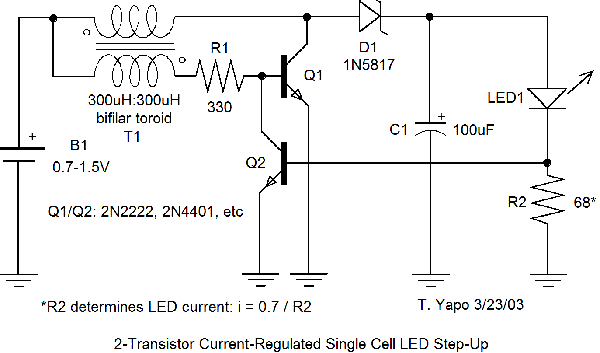

Reference web page with more information is here
Shown here is my contribution to a circuit I found on the internet.
It's a step-up
circuit for driving ultrabright LEDs from a single 1.5V cell. The original
circuit that
this is based on was found on the web. The original circuit works well,
but the
LED current is a strong function of the battery voltage, which ranges
from 1.5 volts
or more for a fresh cell to 0.7 volts at the end of the cell's life.
Striking a balance
between the end-of-life brightness and initial LED current (don't want
to fry the
LED) is difficult. The circuit presented here supplies a constant current
to the LED
over a wide range of battery voltage.
The basic idea is that Q1 and T1 form a blocking oscillator. Initially,
Q1 turns on
because of current drawn through R1. As Q1's collector draws current
through the
transformer primary, an opposite current is induced the secondary,
negating the
drive into Q1's base, turning it off. Meanwhile, the current in T1's
primary
continues to flow, causing the voltage to rise. As the voltage rises
above the level
on C1, the Schottky diode D1 begins to conduct, charging C1. The boosted
voltage
lights the LED. Depending on the battery voltage, the voltage across
C1 will
stabilize at some value, with LED1 drawing some value of current.
At least that's how the original circuit worked. In this version, Q2
and R2 have
been added. Basically, Q2 turns off the oscillator whenever the LED
current gets
too high, turning it back on when C1 discharges to the point that the
LED current
drops below the set value. The action is simple - whenever the voltage
across R2 is
greater than 0.7V, Q2 turns on, robbing Q1 of it's base drive, so it
can't oscillate.
The voltage across R2 is determined directly by the LED current via
V=IR, so for a
specific LED current I, choose R2 = 0.7/I. For example, the shown 68-ohm
resistor
yields a current of I = 0.7/68, or approximately 10mA.
The prototype described below delieved a constant 10mA to a red LED
from 1.5V
all the way down to 0.9V, with the LED staying lit down to about 0.7V.
Higher
currents can be chosen by reducing R2:
R2 LED Current (Approx)
-- --------------------
68 10mA
47 15mA
33 20mA
22 30mA
Overall, this seems like a decent improvement for adding 2 parts.
T. Yapo 3/23/03